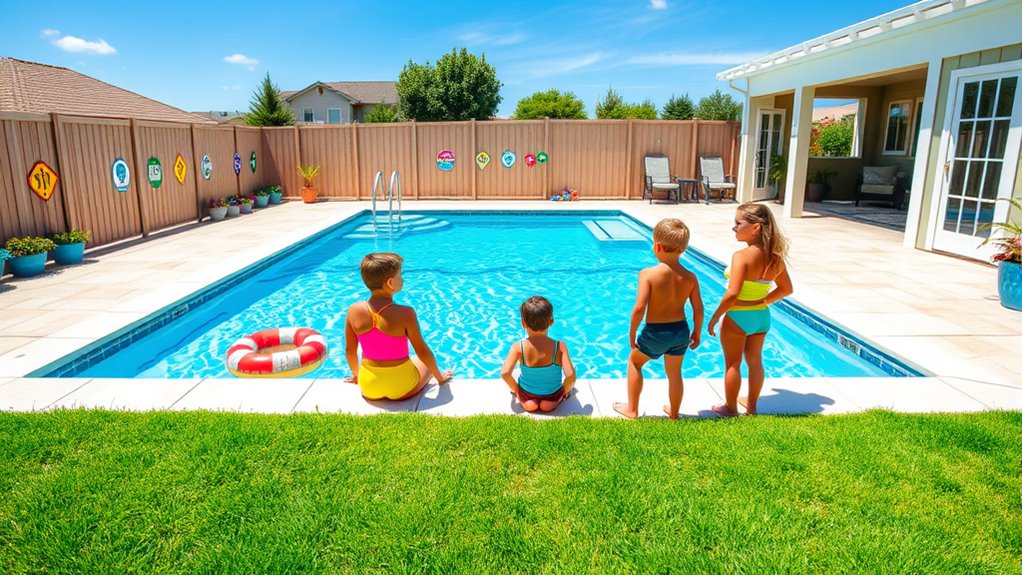To keep your family safe around an endless pool, make certain there’s a secure fence at least four feet high with no gaps, and use self-closing, self-latching gates that lock out kids. Always supervise children closely, never leave them unattended, and teach water safety rules. Install alarms on doors and the water, use safety covers when not in use, and maintain all pool equipment regularly. Setting clear rules and controlling access can prevent accidents—you’ll find many more tips as you explore further.
Key Takeaways
- Install secure fencing, self-latching gates, and safety covers to prevent unauthorized access when the pool isn’t in use.
- Maintain constant adult supervision, teach children water safety rules, and practice emergency response drills regularly.
- Use and regularly test pool alarms, and inspect rescue equipment to ensure quick access during emergencies.
- Perform routine maintenance on pool components, including filters, pumps, and safety devices, to ensure optimal safety and functionality.
- Educate family members on safe pool behavior, enforce strict rules, and restrict access with secure gate locks to prevent accidents.
Secure Fencing and Barrier Requirements
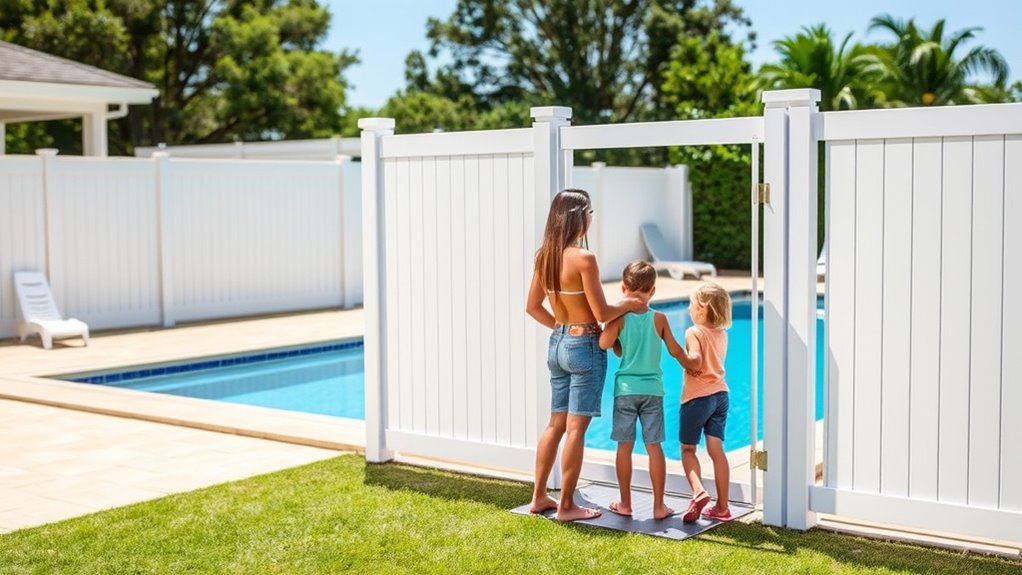
Having a secure fence or barrier around your pool is one of the most effective ways to prevent accidental drownings. You should verify the fence is at least four feet high with no gaps or holes that children could squeeze through. Self-closing and self-latching gates are essential, so they automatically close behind anyone entering or leaving. Keep the latch out of a child’s reach, ideally at least 54 inches above the ground. Regularly inspect the fencing for damage or wear, and repair any issues promptly. Remember, the barrier should completely enclose the pool area, preventing unsupervised access. Additionally, choosing durable materials like porcelain or ceramic fencing can enhance longevity and safety. By maintaining a sturdy, well-designed fence, you create a primary layer of protection that markedly reduces the risk of accidental falls into the water.
Constant Adult Supervision Is Crucial
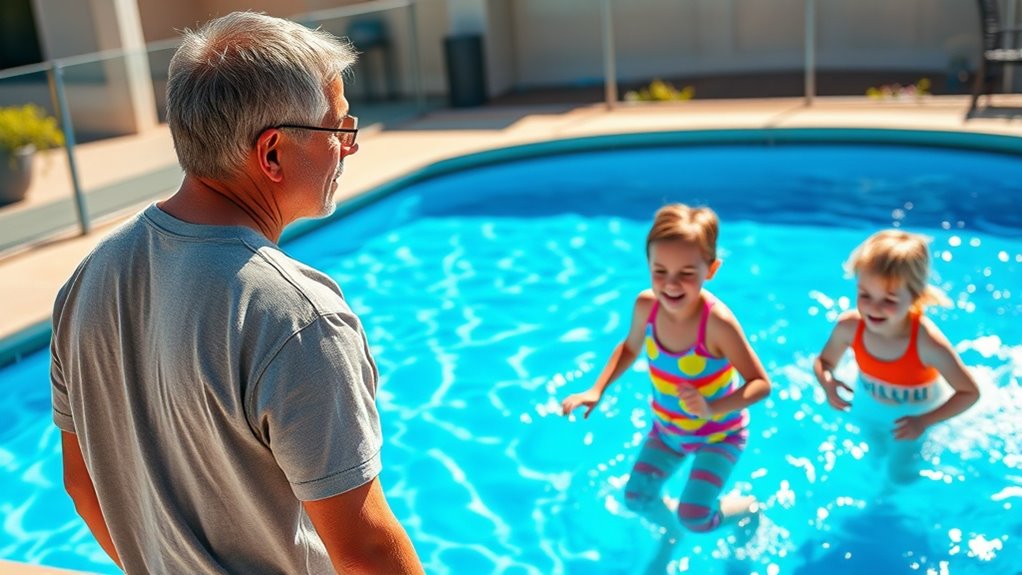
You must always keep an eye on kids when they’re in or near the pool. Never leave them unattended, even for a moment, and assign a specific area as the supervision zone. Staying alert helps prevent accidents before they happen. Additionally, understanding juice detox side effects can help ensure a safe environment for everyone.
Never Leave Kids Unattended
Children can drown in just seconds, so constant adult supervision is essential whenever they are in or near the pool. Never leave kids unattended, even for a moment. Active supervision means you’re paying full attention—no distractions like phones or conversations. Keep children within arm’s reach at all times, especially younger kids or those who can’t swim. Assign a responsible adult to watch the kids during pool time and make sure others know not to interrupt that supervision. Remember, drowning can happen silently and quickly, so vigilance is key. Never assume another adult is watching; always stay alert yourself. By maintaining close, constant supervision, you greatly reduce the risk of accidents and keep your kids safe while they enjoy the pool. Consistent routines and emotional support can help children feel secure during swim time and transitions.
Designate a Supervision Zone
Designating a specific supervision zone is an important step in maintaining constant adult oversight. By clearly marking the area where children are allowed to swim, you reduce distractions and guarantee you’re always nearby. To make this effective, consider these key points:
- Keep the zone within arm’s reach, so you can respond quickly if needed.
- Use visual cues like floating ropes or pool covers to define the boundary.
- Stay within the zone at all times—never turn your attention away, even briefly.
- Incorporate constant supervision techniques to ensure ongoing safety and prevent accidents.
Creating a designated supervision zone helps reinforce supervision as a priority and minimizes accidents. Remember, continuous adult oversight is essential for pool safety, especially with young children. Stay alert and always keep a close eye on swimmers.
Install and Maintain Pool Alarms
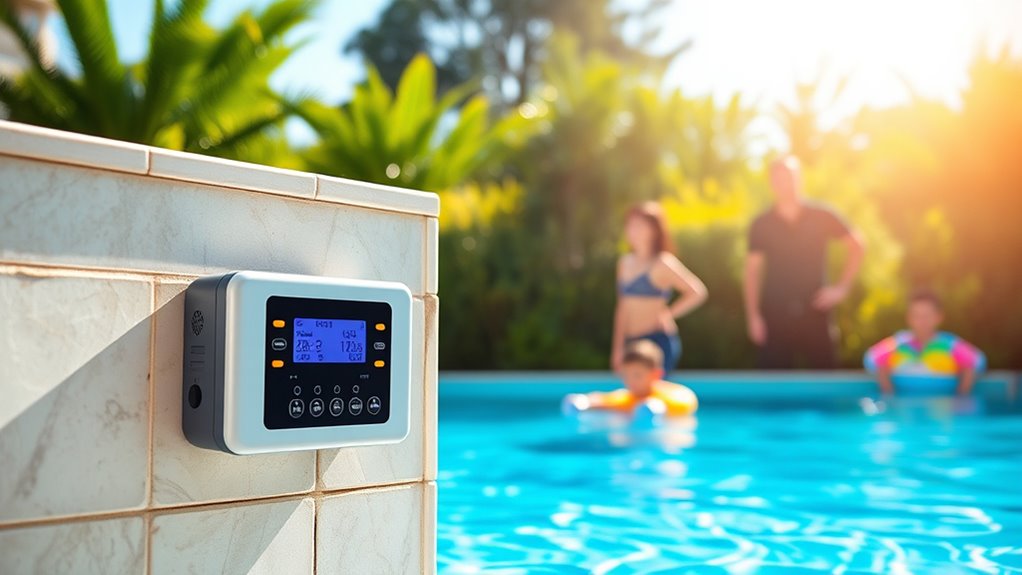
Installing and maintaining pool alarms is essential for guaranteeing safety around your pool area. These alarms alert you instantly if someone enters the pool unexpectedly, giving you vital time to respond. Choose alarms that are specifically designed for pools and ensure they are installed according to the manufacturer’s instructions. Test your alarms weekly to confirm they work properly, and replace batteries promptly to prevent failures. Consider placing alarms on doors leading to the pool area, as well as on the water itself, for all-encompassing coverage. Regularly inspect the alarms for any damage or malfunctions, and keep the sensors clean. Proper installation and consistent maintenance of pool alarms provide an extra layer of protection, helping prevent accidents before they happen. Ensuring your alarms are compatible with air quality standards can also enhance overall safety.
Teach Children Water Safety Rules
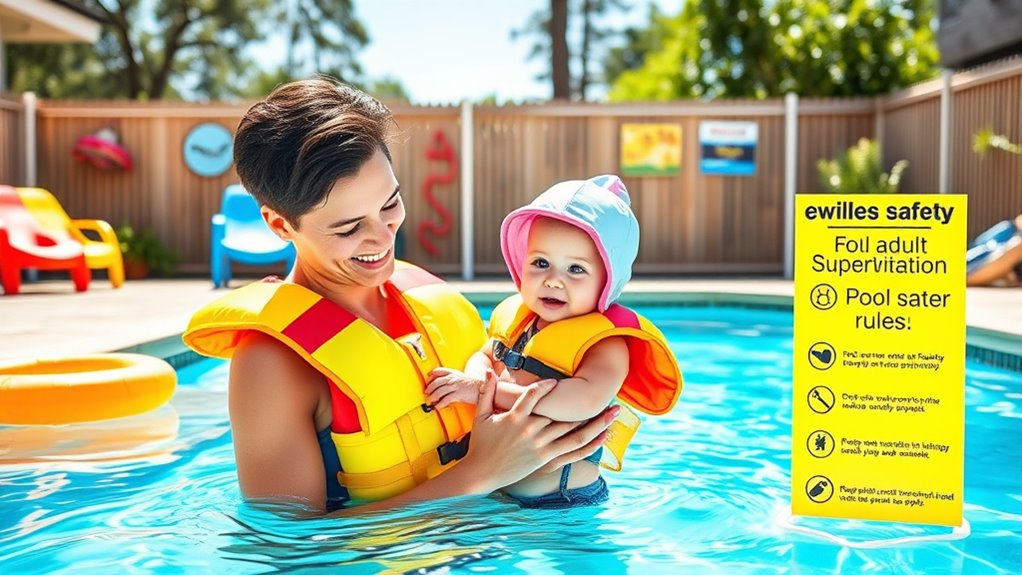
You need to supervise children at all times when they’re near the pool to prevent accidents. Teach them clear water safety rules and make sure they understand and follow each one. Consistent supervision and rule enforcement are key to keeping kids safe. Incorporating water safety practices into their routine can further reinforce safe behavior around pools.
Supervise at All Times
Since children can quickly get into dangerous situations in the water, constant supervision is essential whenever they are in or near the pool. Never leave kids unattended, even for a moment. Staying vigilant helps prevent accidents before they happen. To keep your children safe, consider these tips:
- Always keep your eyes on the kids when they’re swimming or playing near the pool.
- Designate a dedicated adult supervisor who remains alert and engaged.
- Avoid distractions like phones or reading while children are in or around the pool.
- Using eye patches can help improve the appearance of the eye area, but they are not related to water safety or supervision.
Supervision isn’t just about watching; it’s about active engagement and awareness. By staying attentive, you can respond immediately if something goes wrong, reducing the risk of drowning or injury.
Learn and Practice Rules
Teaching children water safety rules is essential for preventing accidents and ensuring they understand how to behave responsibly around the pool. Start by clearly explaining basic rules, like no running, diving, or pushing others. Make sure they know how to enter and exit the pool safely, using ladders or steps. Practice these rules regularly so they become second nature. Reinforce that swimming is only allowed when supervised by an adult and never alone. Use simple language and visual cues if needed. Encourage your kids to ask questions and remind them of the importance of following safety guidelines. Consistent practice helps children develop good habits, reducing the risk of accidents and making pool time safer and more enjoyable for everyone.
Use Safety Covers When Not in Use
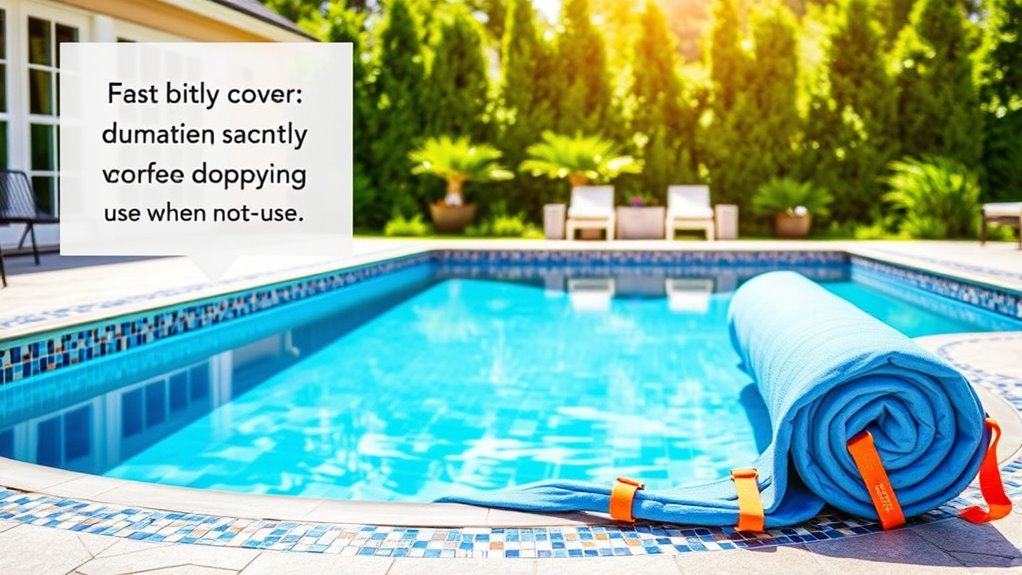
Using safety covers when the pool is not in use is one of the most effective ways to prevent accidental drownings. A properly fitted cover acts as a physical barrier, keeping children and pets out of the water. To maximize safety, consider these tips:
- Ensure the cover is sturdy, in good condition, and securely fastened every time you close the pool.
- Never underestimate the importance of double-checking the cover before leaving the area.
- Choose covers that are specifically designed for safety, such as mesh or solid covers approved for pool safety.
Keep Rescue Equipment Nearby and Accessible
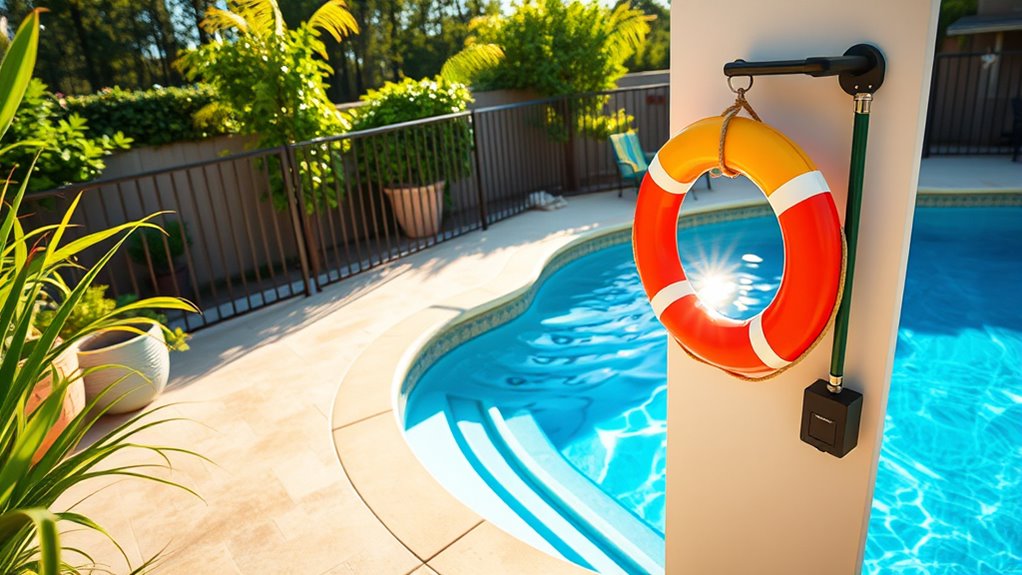
Keeping rescue equipment nearby and easily accessible is essential for quick response in an emergency. You should place items like a life ring, reaching pole, and a first aid kit within arm’s reach of the pool area. This way, if someone is in trouble, you can grab the equipment immediately without searching. Make sure that all family members know where the rescue tools are kept and how to use them properly. Avoid storing rescue gear in locked cabinets or hard-to-reach places, as every second counts during a rescue. Regularly check that the equipment is in good condition and ready to use. Ensuring that rescue tools are properly maintained and regularly inspected can prevent failure during an emergency. Keeping rescue tools accessible ensures you’re prepared to act swiftly, potentially saving a life during an emergency.
Regularly Inspect and Maintain Pool Equipment
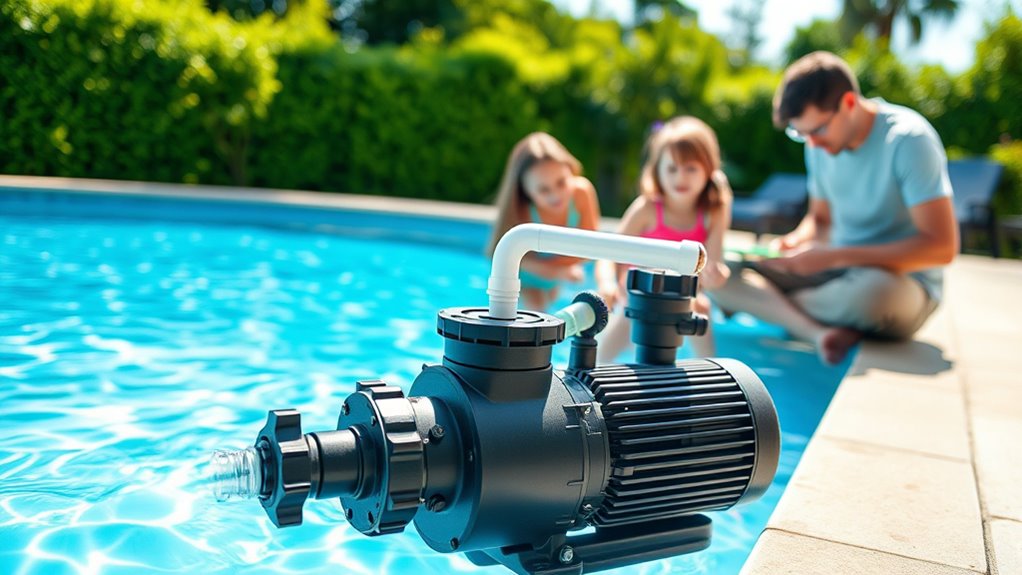
You should check your pool equipment regularly to catch any issues early. Keeping pool components clean and in good condition helps prevent accidents and equipment failure. It’s also wise to schedule professional inspections to guarantee everything stays safe and functioning properly. Additionally, monitoring the air quality around your pool area can help identify potential hazards and ensure a safe environment for your family.
Check Equipment Regularly
Regularly inspecting and maintaining your pool equipment is essential to guarantee safety and proper operation. By staying proactive, you can identify issues before they become hazards. Here are three key items to check:
- Inspect pumps and filters for leaks, cracks, or unusual noises that could indicate malfunction.
- Test safety features like automatic shut-off switches and alarms to ensure they’re working correctly.
- Examine hoses and connections for wear, corrosion, or loose fittings that could cause leaks or failures.
- Review your pool’s Honda Tuning systems periodically to ensure all electronic components are functioning properly and safely.
Perform these checks weekly to prevent equipment failure and maintain a safe swimming environment. Address any problems immediately, and schedule professional maintenance when needed. Consistent oversight keeps your pool running smoothly and keeps everyone safe.
Clean Pool Components
To guarantee your pool remains safe and inviting, it’s essential to regularly inspect and maintain all pool components. Clean filters, skimmers, and pumps to prevent clogs and ensure proper circulation. Remove debris from skimmer baskets and brush the pool walls to prevent algae buildup. Check for signs of wear or corrosion on hoses, valves, and fittings, replacing damaged parts immediately. Keep the pump area tidy and free of obstructions to maintain airflow. Regularly inspect the chlorinator and pH balance equipment to ensure water quality. Properly maintained components prevent malfunctions that could compromise safety or cause costly repairs. Establish a routine cleaning schedule to keep your pool in top condition, reducing the risk of accidents and extending the lifespan of your equipment.
Schedule Professional Inspections
Scheduling professional inspections for your pool equipment guarantees that all systems operate safely and efficiently. Regular check-ups help identify issues early, preventing costly repairs and potential safety hazards. During inspections, professionals examine crucial components like filters, pumps, and electrical systems to ensure they’re functioning correctly.
To maximize safety, consider these three key areas:
- Inspect and test the electrical wiring to prevent shocks or fires.
- Check the pump and filter operation to ensure proper water circulation.
- Evaluate the pool heater and safety covers for damage or wear.
Educate Family Members on Pool Emergency Procedures
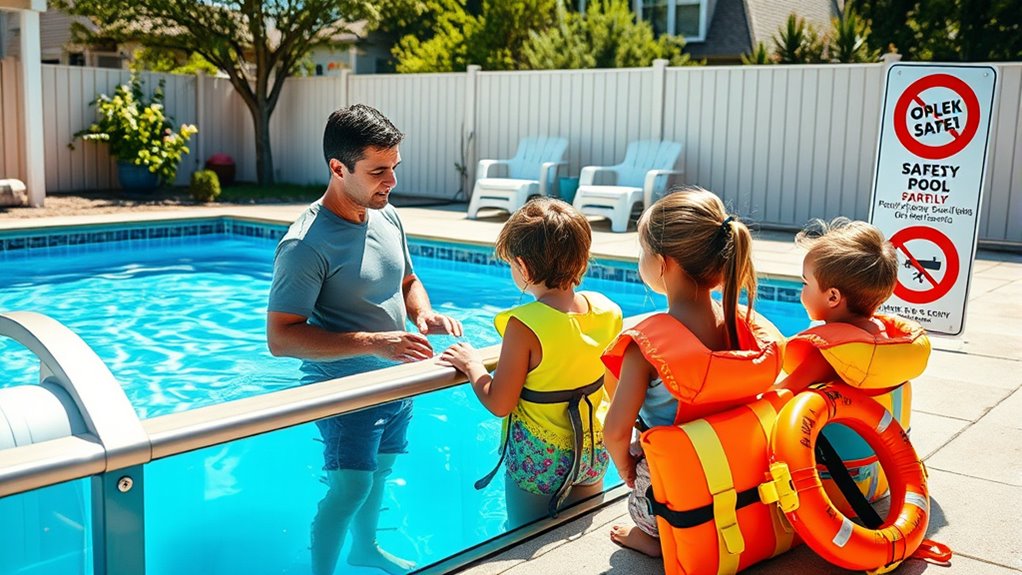
Understanding what to do in an emergency can make all the difference if someone is in trouble in the pool. You should teach every family member, including kids, how to recognize signs of distress and respond quickly. Show them how to call for help and where safety equipment, like life rings and reaching poles, are located. Practice basic rescue techniques, such as reaching, throwing, and, if trained, performing CPR. Make sure everyone knows to stay calm and avoid panicking. Regular drills can help reinforce these procedures, so responses become second nature. By educating your family on emergency protocols, you’ll ensure everyone is prepared to act swiftly and confidently, reducing the risk of serious accidents and saving lives in critical moments.
Limit Access With Keyed or Locked Gates
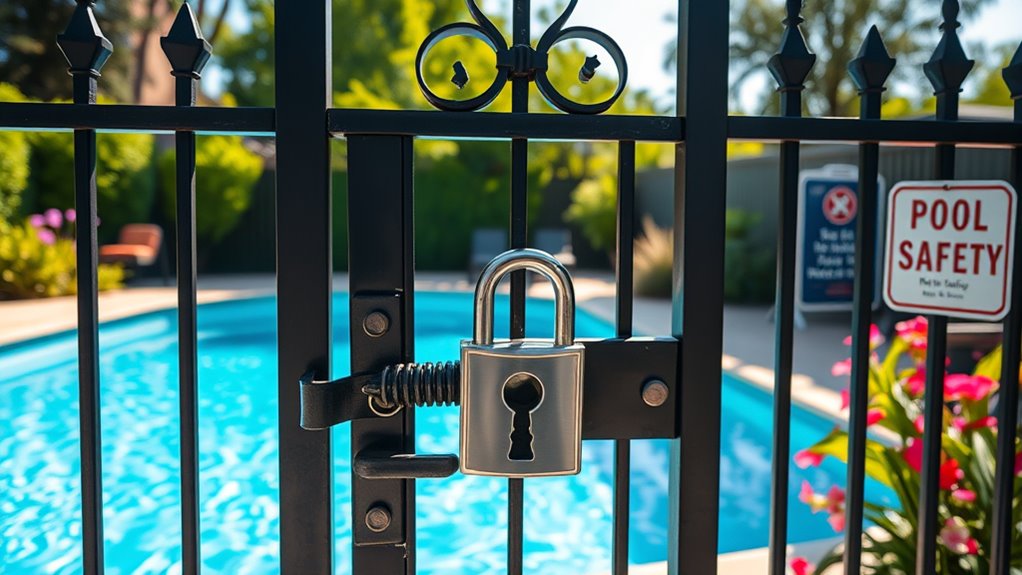
Installing keyed or locked gates around your pool is one of the most effective ways to prevent unauthorized access and keep children safe. Confirm the gate is self-closing and self-latching, so it automatically shuts after use. Regularly check that the lock works properly and isn’t easily bypassed. Consider these key safety features:
- Use high-quality locks that require a key or combination to open.
- Install gates at all pool entry points, including side doors and walkways.
- Keep keys out of children’s reach and only give access to responsible adults.
Set Clear Rules for Pool Usage and Behavior
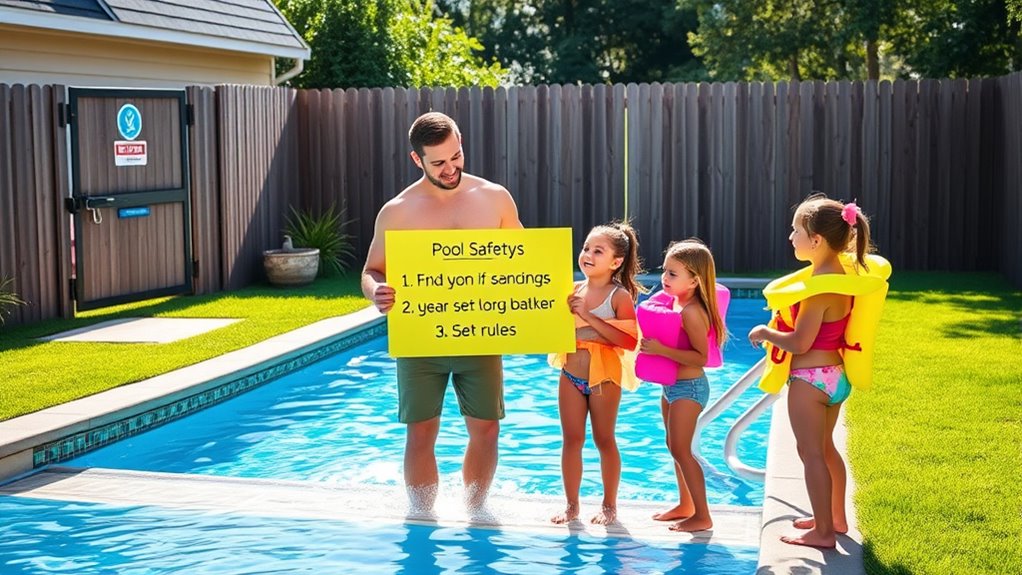
To guarantee everyone stays safe, it’s essential to establish clear rules for pool usage and behavior. Make sure all family members and guests understand that no running, roughhousing, or diving is allowed in the pool area. Children should always be supervised by an adult when in or near the pool. Specify that only designated swimmers use the pool, and prohibit swimming alone. Set rules for proper pool entry and exit, such as using steps or ladders carefully. Emphasize that equipment like floaties or toys should be used responsibly. Enforce a no-alcohol policy for swimmers, especially for those supervising children. Clear rules help prevent accidents and ensure everyone enjoys the pool safely. Regularly review and reinforce these guidelines with all users.
Frequently Asked Questions
How Can I Ensure My Pool Area Is Child-Proof Beyond Fencing?
You can guarantee your pool area is child-proof beyond fencing by installing safety alarms on doors and windows leading to the pool, keeping rescue equipment nearby, and regularly supervising children when they’re outside. Consider using pool covers when not in use and removing toys from the water after swimming to prevent accidental falls. Additionally, teach your kids about pool safety and establish clear rules to keep everyone safe.
What Are the Best Practices for Teaching Non-Swimmers Water Survival Skills?
You know what they say, “Better safe than sorry.” To teach non-swimmers water survival skills, start with basic floating and breath-holding exercises in shallow water, gradually progressing as they gain confidence. Always supervise closely and use life jackets when necessary. Practice reaching and throwing assists, and teach them how to call for help. Consistent, positive reinforcement helps build their skills and comfort around water, ensuring they stay safe.
How Often Should Pool Safety Equipment Be Inspected or Replaced?
You should inspect your pool safety equipment monthly to make certain it’s in good condition. Replace any damaged or worn items immediately, especially life vests, goggles, or rescue equipment. Regular inspections help prevent accidents and ensure quick response in emergencies. Also, test safety devices like alarms and covers periodically. Keeping everything in top shape guarantees you’re prepared and your family stays safe during pool use.
What Steps Should We Take if Someone Is Drowning or in Distress?
If someone is drowning or in distress, act quickly and stay calm. Call 911 immediately, then reach or throw a flotation device to them. If you’re trained, perform CPR until help arrives. Keep your eyes on the person and avoid entering the water unless necessary. Remove any hazards nearby, and reassure the person if conscious. Your swift action can save lives in critical moments.
How Can I Make Pool Safety Rules Understandable for Young Children?
Your voice is the most powerful tool to make pool rules stick. Use simple words and short sentences, like “No running,” or “Never swim alone.” Show enthusiasm and praise when they follow rules, making safety fun rather than a chore. Use colorful signs or pictures near the pool, and practice rules regularly. When kids understand, they’ll see safety as second nature, turning your pool into a safe, happy place.
Conclusion
By following these safety tips, you’re creating a safer environment for everyone. But remember, even the best precautions can’t replace constant vigilance. Imagine a moment where a simple oversight turns into a crisis—staying alert and prepared is your best defense. Keep safety at the forefront, and always be ready to act. Because when it comes to pool safety, a quick response can make all the difference—don’t let your guard down, not even for a second.

